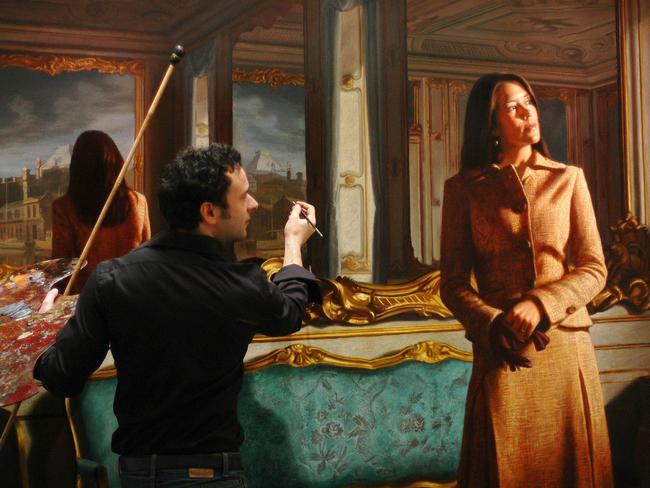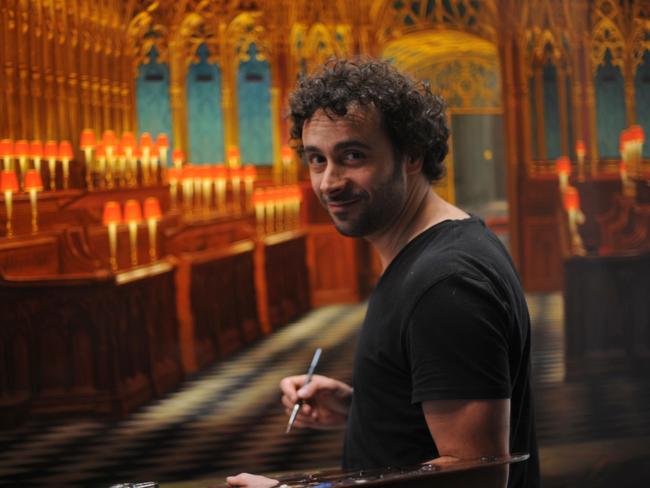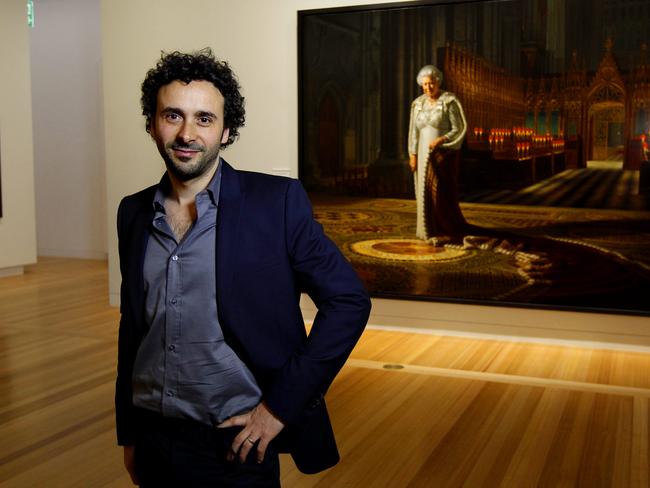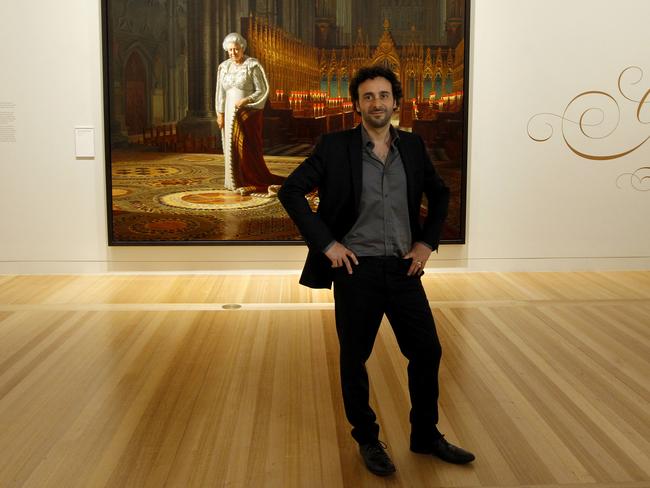A FORMER Sydney schoolboy who once missed out on the Archibald Prize is now one of Europe’s leading royal portrait artists.
Ralph Heimans has become the portrait artist of choice for the British and Danish royal families, his stunning pictures hanging in palaces and galleries across Europe.
He has painted the official portraits of Queen Elizabeth, Prince Philip, the Danish Crown Prince Frederik and his Tasmanian-born wife Crown Princess Mary. Another major project is under way, with details under wraps.
The secret to painting a royal family member, according to Heimans, is to see beyond the enormous weight of their public roles, and look into their soul.
“It’s not like painting anybody else,’’ Heimans, 48, told News Corp over coffee and scones at Westminster Abbey, where his acclaimed portrait of Queen Elizabeth from her Diamond Jubilee year in 2012 has just gone on permanent display in a new gallery.
“I can see beyond the role and the status to the person, how the royal family inhabits that role.
“They don’t have free agency in their lives like we do.
“Maybe this is something about being Australian. That perspective, and being able to humanise it. To see past the façade to the soul.’’
Heimans’ glorious oil portraits are huge – the central characters are life-sized, and they are often surrounded by large, elaborate palace rooms.
When he is immersed in a painting, he spends up to 20 hours a day working, climbing up and down ladders, mixing his own paints to get the colours just right, building the painting by layers.

He spends weeks and sometimes months researching his subjects – including, in the case of his portrait of the Queen, two nights in Westminster Abbey with a team of technicians, ensuring he had the lighting he was going to capture just right.
And it all started back in Sydney in the 1980s, where he first learned the basics of portraiture at Mosman High School’s excellent arts program.
“I always knew I wanted to be a portrait painter,’’ he said. The teachers nurtured his talent and encouraged him.
“Things really changed when I was awarded the awarded the national art prize for high school students.’’
The award was sponsored by News Corp and the 17-year-old Heimans was handed his award by the company’s boss, Rupert Murdoch, and then-prime minister Bob Hawke.
The prize was a cheque for $2500 — a small fortune back then — enough to allow Heimans to pack himself off to Europe to study art for three months.

But he couldn’t find what he was looking for – a dedicated course to teach him realism, oils, anatomical perspective. He came home discouraged.
“Realism painting was not in vogue,’’ he said of that time. “I began to piece together my own education.’’
Heimans is one of three children born to documentary-maker Frank Heimans and French teacher Josette Levy, who was raised Jewish in Beirut in Lebanon. His sister Ingrid is a psychologist and his brother Jeremy is a New York-based community activist who founded GetUp! in Australia.
Frank had been born to Jewish parents who were sheltering in the small Dutch town of Tilburg during the Holocaust.
“They were lucky to survive. They came out (to Australia) in the 1950s,’’ Heimans said.
The pair met after Ms Levy’s family also moved to Australia in the 1960s.
Heimans was fascinated from a young age with the Dutch masters, such as Rembrandt and Vermeer.
“They were my cultural inspiration, with a fresh Australian perspective.’’
Unsure how to make a living out of his love for portraiture, Heimans decided to study architecture at Sydney University.
As well as being a talented artist, he was always very good at maths, for reasons he doesn’t fully understand.
“Maybe it’s the abstract concepts. It’s all problem solving and that’s what I do with my paintings. Geometry and perspective. There are strong mathematical undertones,’’ he said.
“I thought architecture could be a solution.’’
It wasn’t a solution. After a year, he was invited by his teachers to consider another career choice.
No one, it seemed, shared his enthusiasm for “European monolithical structures and Renaissance edifices in Ultimo’’.
“I basically got kicked out,’’ he recalled. “Which was fine, it definitely worked out.’’
He left on excellent terms – one of his architecture lecturers became the first person to pay him for a portrait – and enrolled in a Bachelor of Arts majoring in pure mathematics and fine arts (history and theory).

The commissions started to slowly trickle in.
Living in a shack at Bondi Beach, he painted in a makeshift studio in the attic, and studied, then, through his father, he met Michael Kirby, the activist judge. It was the pivotal moment in his career.
Kirby agreed to Heimans’ request to sit for him for a portrait that Heimans wanted to enter into the Archibald Prize, Australia’ premier art award.
The beautiful painting, named “Radical Restraint’’, now hangs in the National Portrait Gallery in Canberra. Kirby and Heimans became firm friends and Kirby has continued to support and nurture his career.
But the painting failed to find favour with the Archibald judges, and the set-back was enough to convince Heimans it was time to explore his love of European art by leaving Australia and immersing himself in Europe.
“It was a bit of a trigger,’’ he said.
“I was heading that way anyway. It was a no-brainer that Europe would be a source of inspiration for me.’’
He never entered the Archibalds again, mainly because he doesn’t have time, and he’s been away from the country too long to meet the residency requirements for entry.
“I think however that the prize is a great way to engage the public’s interest in portraiture and I’m always interested to see it when I’m in town,’’ he said.
In 1997, he moved to Paris and lived the archetypical life of an artist: painting portraits in a house on a cobblestoned street on the slopes of Montmartre, under a roof that leaked, metres away from what used to be Picasso’s workshop.

“It was a real-life little village in Paris, with a baker, a florist down the road, like a Yoplait commercial,’’ he said.
“It was such an amazing place to live, I was really living the cliché, Montmarte, it was just amazing.’’
The commissions kept coming in — most of them from London. He caught the Eurostar between Paris and London. He met the woman who would become his wife, Tami Bokey, an Australian living in London.
His big break came in 2005, when he was selected to paint an official portrait of the Tasmania-born Crown Princess Mary in Denmark.
The project, delivered jointly by the National Portrait Gallery in Canberra and the Danish National Gallery, saw Heimans chosen from a shortlist, picked out by a small group including Princess Mary herself, who liked his style and the narratives he told in his paintings.
“It all started when I got the commission for Princess Mary,’’ he said.
“It opened up this new world.’’

Here’s what you can expect with tomorrow’s Parramatta weather
As winter sets in what can locals expect tomorrow? We have the latest word from the Weather Bureau.
Here’s what you can expect with tomorrow’s Parramatta weather
As we move into winter what can locals expect tomorrow? We have the latest word from the Weather Bureau.